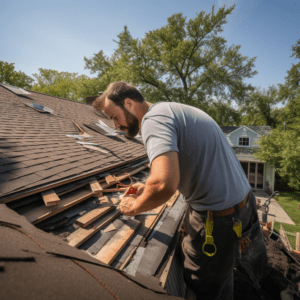Roof repair services play an essential role in addressing and resolving common roof problems. As the structural component that protects buildings from external elements, roofs are prone to damage over time. This article aims to provide a comprehensive understanding of the signs indicating the need for roof repair, the pros and cons of DIY repairs versus hiring professionals, considerations in selecting appropriate roofing materials, as well as the significance of regular roof maintenance. By exploring these aspects, readers will gain valuable insights into ensuring the longevity and functionality of their roofs.
Key Takeaways
- Promptly addressing common roof problems and signs of damage can prevent further deterioration and more extensive repairs in the future.
- Hiring a professional for roof repair provides specialized knowledge, skills, and access to industry-standard materials.
- Choosing the right roofing material and properly maintaining it can extend the lifespan of the roof.
- Regular maintenance ensures the long-term functionality of the roof and prevents potential damage.
Common Roof Problems
Common roof problems can include leaks, missing shingles, and damaged flashing. Leaks are one of the most common issues homeowners face with their roofs. They can occur due to various reasons such as damaged or deteriorated roofing materials, improper installation, or severe weather conditions. Leaks not only lead to water damage but also pose a threat to the structural integrity of the building if left unaddressed.
Missing shingles are another prevalent problem that can affect the functionality and aesthetics of a roof. Shingles may go missing due to strong winds, aging of the roofing system, or poor-quality installation. When shingles are missing, it exposes the underlying layers of the roof to potential damage from rainwater or UV radiation.
Damaged flashing is yet another issue that can cause significant problems for roofs. Flashing refers to thin pieces of metal or other materials used around joints and edges on a roof to prevent water seepage. Over time, flashing can become corroded or detached, leading to water infiltration and subsequent damage.
It is crucial to address these common roof problems promptly in order to prevent further deterioration and more extensive repairs in the future. Regular inspections by professionals can help identify these issues early on and ensure timely repairs are carried out.
Signs You Need Roof Repair
Evident indications of potential structural damage to the uppermost covering of a building can include sagging, discoloration, and the presence of leaks. These signs are often indicative of roof problems that require immediate attention and repair. Sagging in the roof can be caused by various factors such as excessive weight from accumulated debris or water, weakened trusses or rafters, or poor construction techniques. Discoloration on the roof surface could suggest the presence of algae, moss, or lichen growth, which not only affects the aesthetic appeal but also compromises the integrity of the roof material over time. Leaks are perhaps one of the most obvious signs that a roof is damaged and in need of repair. The presence of water stains on interior walls or ceilings, damp spots on attic insulation, or dripping water during rainfall clearly indicate that there is an issue with the roofing system. It is important to address these signs promptly to prevent further damage to both the roof structure and interior components of a building. Regular inspections by professional roofing contractors can help identify these signs early on and facilitate timely repairs before extensive damage occurs.
DIY Roof Repair Vs Hiring a Professional
When considering the maintenance of a building’s uppermost covering, an important decision arises between individuals performing repairs themselves or seeking assistance from a professional. This choice has significant implications for the longevity and effectiveness of the roof repair. DIY roof repair may seem like a cost-effective option, but it comes with certain risks and limitations.
While undertaking roof repairs oneself can save money on labor costs, it requires a certain level of expertise to ensure proper execution. A lack of knowledge about roofing materials, techniques, and safety precautions can lead to subpar repairs that may exacerbate existing problems or create new ones. Furthermore, inadequate repairs can compromise the structural integrity of the entire building.
Hiring a professional for roof repair provides several benefits. Firstly, professionals possess specialized knowledge and skills acquired through training and experience. They are equipped with the necessary tools, equipment, and materials to carry out effective repairs efficiently. Additionally, professionals have access to industry-standard materials that are often not readily available to individuals attempting DIY repairs.
Moreover, hiring a professional offers assurance in terms of quality workmanship and warranty coverage. Reputable roofing companies typically provide guarantees for their services which ensures that any issues arising from their work will be rectified at no additional cost.
Choosing the Right Roofing Material
One important factor to consider when choosing the right roofing material is its durability and ability to withstand various weather conditions. The durability of a roofing material refers to its ability to resist wear, damage, and deterioration over time. It is crucial for a roofing material to be able to withstand different weather conditions such as rain, snow, wind, and extreme temperatures.
There are several roofing materials available in the market that offer varying degrees of durability. One commonly used durable roofing material is asphalt shingles. They are known for their strength and ability to withstand harsh weather conditions. Asphalt shingles have a lifespan of around 20-30 years and can resist heavy winds up to 130 mph.
Metal roofs are another option known for their durability. They can last up to 50 years or more and are resistant to fire, insects, rotting, and mildew. Metal roofs also perform well in areas prone to heavy rainfall or snowfall as they shed water easily.
Other durable roofing options include clay tiles, concrete tiles, slate shingles, and synthetic materials like rubber or plastic-based products. These materials offer long lifespans ranging from 50-100 years with proper maintenance.
The Importance of Regular Roof Maintenance
Regular maintenance of a building’s roofing system is crucial in order to prevent potential damage and ensure its long-term functionality. The roof serves as a protective barrier against external elements, such as rain, snow, wind, and sunlight. Over time, these elements can cause wear and tear on the roof, leading to leaks, cracks, or even structural damage. Regular maintenance allows for the identification and timely repair of any issues before they escalate into more significant problems.
One key aspect of regular roof maintenance is inspection. A thorough inspection should be conducted at least twice a year by trained professionals who can identify potential issues that may not be immediately apparent to an untrained eye. This includes checking for loose or missing shingles, damaged flashing, clogged gutters or drains, and signs of moisture infiltration.
In addition to inspections, routine cleaning is also essential for maintaining a healthy roofing system. Debris such as leaves, branches, and dirt can accumulate on the roof’s surface over time and block drainage systems. If left unattended, this debris can lead to water pooling on the roof and causing leaks or damage.
Timely repairs are another critical aspect of regular maintenance. Any identified issues during inspections or cleaning should be addressed promptly to prevent further deterioration or costly repairs down the line.
Overall, regular roof maintenance is vital for ensuring the longevity and functionality of a building’s roofing system. By implementing proper upkeep practices such as inspections, cleaning, and timely repairs when necessary; potential damage can be mitigated while extending the lifespan of the roof structure itself.




